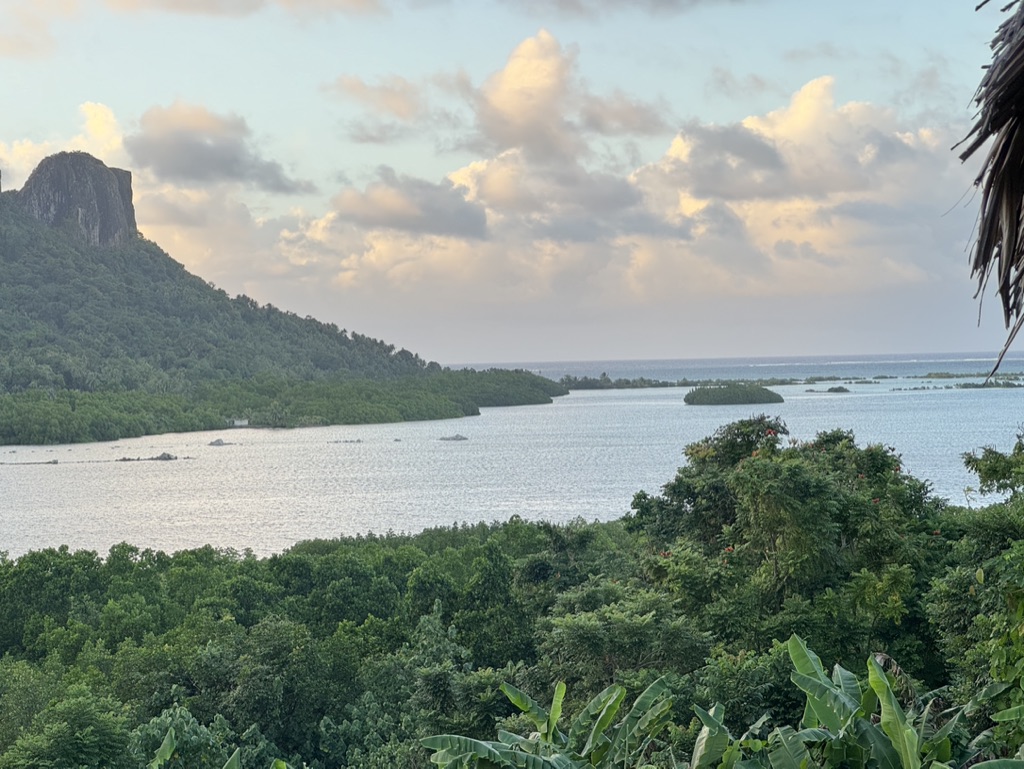This page provides an accessible summary of the research paper, Caenorhabditis diversity on Pohnpei, Micronesia, provides evidence that the Elegans Supergroup has its roots in the Americas and diversified in the Pacific en route to Asia, in Pohnpeian and English.
Summary in Pohnpeian
Kepikipik kan me rasehng mahn oh tuhke kan nan Pohnpei inenen weksang wasa teikan nan sampah, kepikipik pwukat kolokol pasepeng oahng ekei kalelapak kan me pidada mwomwen ehu ehu kepikipik kan ahr par peseng nin sampah. Se kapatahieng ehu ire oahng kepikipik en Pohnpei kan sang ni aht kasawiadahr pwihn en mwahs ehu me kahdaniki Caenorhabiditis nematodes. Pwihn en mwahs wet me inen tikitik me kakete en lapalahki milimeter ehu reirei oh aramas pan kerenieng en sohte kak en kilangada mare pahn sohte daodoahngki kilahs akan pwehn kak en kasawiada mwahu oh pwihn en mwahs wet kin iang sawas kamwadangahla wah oh tehn tuhke kan pweren kak en wiahla pwehl. Ehu pwihn en mwahs sang nan Caenorhabditis nematode, me iei C. elegans, petehk ehr nan wasahn petehk keneinei kan nan sampah pwehn wia mehn kaweid oh kedehde mwomwen mahn akan oh aramas en pil kak en esehla mwomwe rail oh dah re wiahng ieias en mour.
Sawas akan me sang ihr men Pohnpei tohto, ahpw mehlel Holden Pelep oh Zelnick Moses, se rik penehr mwahs tohto sang nan wahn tuhke epwiki samwa kei pidahkihdi wasa tohto nan Pohnpei. Mwahs menet e wia mwahs ehu me kalapw pwarada nan soangsaongen wahn tuhke tohto, me rasehng pwuhr, kotop, oh nihn. Se diar peneinein mwahs Caenorhabditis nematode diwahu. Meh limahu sang nan mehka saik petehkpe wiawiehng pak ehu, oh se kieng ede rail oh kawehwepe rail me soan. C. pwilidak me inenen rehk de tohto oh kin dierek nan wasa koaros. C. losolos, C. nansapw, oh C. mwetiwel kin dierekte wasa karkarahk kan oh wasahkan me aramas kin koadaohke. C. ileile kin dierek nan wel akan.
Ouraman en reprep wet, sen kak en esehla ia mwomwen mahn menet oh doupeseng nan sampah. Se kasawiher DNA en pwihn en mwahs kapw limahu sang Pohnpei oh meh weneisek limau sang ni pwihn en mwahs wet oh wahn reprep wet kasalehda me re kakete tepdohsang America. Sang ni seiloak kan me wiawi sang America kodohng nan pacific, mwahs pwukat uhd kanaitikiada soangsoangen pwihn en mwahs tohtohkei me koukousoan nan Pohnpei, Hawaii, oh Moorea. Pwihn en mwahs pwukat me dierek nan pacific wet re kak en tepdohsang Asia, Australia, oh Africa oh irial kan me pil kohla oh kousoanla America. Biologist kan kalapw medewe me mwahs pwukat en dekehn pacific kat re udahn tepdohsang sapw laud kan ahpw aht petehk oahng pwihn en mwahs wet nan Pohnpei kadehdeda me ih ehu wasa me mwahs pwukat pil tepsang ie iei nan dekehn pacific kat.
Translated from English by Micronesian Productions
Summary in English
Pohnpei is home to many plants and animals that occur nowhere else in the world, and its biological diversity holds answers to questions about how organisms have come to be distributed across the globe. We added to knowledge of Pohnpei’s biodiversity by characterizing local species of a group of tiny worms known as Caenorhabditis nematodes. These harmless worms are about one millimeter long, too small to see without magnification, and they eat microbes in rotting fruit and flowers, contributing to the decomposition process that turns decaying vegetation into soil. One species of Caenorhabditis nematode, C. elegans, is studied in hundreds of research laboratories around the world as an easy-to-study example animal, with the lessons learned from C. elegans informing our understanding of basic biology and human health.
With help from many Pohnpeians, especially Holden Pelep and Zelnick Moses, we collected worms from hundreds of samples of rotting fruits and flowers from many parts of the island. The worms were common in the rotting fruits and flowers of many native species, such as pwuhr, kotop, and nihn. We found nine different species of Caenorhabditis nematode. Five of these have never been described before, and we gave them formal descriptions and names. C. pwilidak was the most common species, occurring at all elevations. C. losolos, C. nansapw, and C. mwetiwel were found only at low elevations, and only in regions affected by human activities. C. ileile was found only in the cloudforest.
A goal of our study was to learn about how Caenorhabditis nematodes have come to be distributed all over the world. We compared the DNA of the five new species from Pohnpei and 65 other species of Caenorhabditis, and the results suggest that the very ancient ancestors of the Pohnpeian worms lived in the Americas. After moving from the Americas into the Pacific, the worms gave rise to many different species that now live in Pohnpei, Hawaii, and Moorea. Eventually, these Pacific worms gave rise to lineages that live in Asia, Australia, and Africa, as well as a lineage that moved back to the Americas. Biologists usually think of Pacific islands as recipients of species from the continents, but our analysis of Pohnpei’s worms suggest that the islands also serve as sources of continental species.
